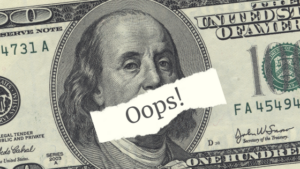I find that while managing your taxes throughout the year is important for all retirees, many folks often focus on them primarily in the first few months of every year. This obviously makes sense, given that April 15 is the annual tax deadline for the previous filing year.
Interestingly enough, I actually had a recent conversation with my oldest daughter, Maeve, about this very topic. She’s taking a college course Taxation and Ethics and was telling me what she was learning about. She brought up the topic of Requirement Minimum Distributions (RMDs) in particular. Being a “starving college student”, she found it puzzling that anybody would try to purposely not take money out of their retirement account. I chuckled and explained that there are a lot of folks who, after saving, investing and penny-pinching for decades, now have more than enough to live on and don’t necessarily want to start draining all of their accounts. Those with a pension plan, too, have a leg up on a lot of others since pensions have pretty much gone the way of the dinosaur. For them, their pension income and Social Security payments are enough to cover most of their living expenses, so they’d prefer to let their other assets growing.
If you’re one of these lucky retirees who finds yourself in this enviable position, unfortunately, Uncle Sam doesn’t really care whether or not you don’t need the money you’ve accumulated in your 401k, IRA or other qualified retirement plan. Once you hit age 72, you’re required to start taking annual RMDs – and paying Uncle Sam his due in taxes – each year. The funds in these plans have never been taxed and have been allowed to grow tax deferred during your working years. The IRS requires that you start making those tax payments starting at age 72. The amount you need to withdraw each year will be calculated using IRS-created life expectancy tables and the percentage you must take will increase each year as you get older. Failing to take your RMD will result in a stiff penalty, too – you’ll owe an additional 50% penalty for any amount you’re required to take but don’t.
Unfortunately for many, these forced distributions can have repercussions. Not only do you need to pay some of “your” retirement funds to the IRS, but these withdrawals are considered income which could push you into an overall higher tax bracket for the year, among other things. For this and numerous other reasons, some folks would benefit from limiting these distributions where possible.
This week, with our time together, I’d like to offer four strategies that may help you limit your RMDs if you find you don’t need – or want – the additional income. One straightforward answer is to simply keep working. If you have a company 401(k) and are working past age 72 (and don’t own 5% or more of the company), can delay distributions from your 401(k) at your current workplace until you retire. Note that this applies only to the 401(k) with your current employer. It doesn’t apply to a 401(k) you may have with a former employer, or any fund held within an IRA.
Another possible strategy is to convert some or all of your savings into a Roth IRA. Unlike a traditional IRA or Roth 401(k), which require RMDs, a Roth IRA doesn’t require any distributions at all. That means the money can stay in the plan and continue to grow tax-free for as long as you want.
The funds being converted have not yet been taxed, so you will owe taxes on any converted funds in the year of the conversion, but after that you don’t have to pay taxes on withdrawals from earnings if you are over 59½ and you have had the account open for five years or more. You’ll want to review this option carefully with a financial and tax professional to ensure it doesn’t negatively impact your current tax situation.
Another option is to strategize your very first RMD. Retirees who turn 72 have until April 1 of the following calendar year to take their first distribution. After that, they must take it by Dec. 31 on an annual basis. The strategy here is to hold off on taking your first RMD in the year you turn age 72 and take it the following year before April 1. This can be beneficial if you think you’ll be in a lower tax bracket when you retire in that second year. But keep in mind, you’ll then have to take two distributions in the next year, which will result in more income that the IRS will tax. It might make more sense to instead take your first distribution as soon as you turn 72 (unless you expect to end up in a significantly lower tax bracket) to prevent having to draw down twice in the first year.
An option for those who are charitably inclined is to donate your RMDs to a qualified charity. This is known as the qualified charitable distribution (QCD) rule. (Note that it does not apply to a 401(k) plan, it’s a strategy for your traditional IRA assets). If your contribution is $100,000 or less—and is rolled out of the IRA and directly to the charity—you won’t have to pay taxes on the RMD. This can be a great way to save on paying taxes while donating to a charity close to your heart. Note, though, that RMDs you donate to a worthy cause or group cannot be deducted from your taxes as a charitable contribution; you can’t have the tax break both ways.
A lot of folks depend on RMDs to provide retirement income, for sure. But if you have other assets to get you through, consider one of these strategies to help limit your withdrawals and potentially save on taxes.
And as always – be vigilant and stay alert, because you deserve more!
Have a great week.
Jeff Cutter offers investment advisory services through Cutter Financial Group, LLC, an SEC Registered Investment Advisor with offices in Falmouth, Duxbury, and Mansfield.
Jeff can be reached at jeff@cutterfinancialgroup.com. Insurance products, including annuities, are offered through Cutterinsure, Inc., (MA insurance license #2080572). Cutter Financial Group and Cutterinsure are affiliated and under common control but offer services separately. Members of Cutter Financial Group’s management receive revenue directly from Cutterinsure. Any compensation received is separate from and does not offset regular advisory fees. Cutter Financial Group does not charge advisory fees on any insurance products. We do not offer tax or legal advice. Always consult with qualified tax/legal professionals regarding your own situation. Investing in securities involves risk, including possible loss of principal. Insurance product guarantees are backed by the financial strength and claims-paying ability of the issuing company. This article is intended to provide general information. It is not intended to offer or deliver investment advice in any way. Market data and other cited or linked-to content in this article is based on generally available information and is believed to be reliable. Please contact us to request a free copy of Cutter Financials’ Form CRS, Form ADV 2A and applicable Form ADV 2Bs.








